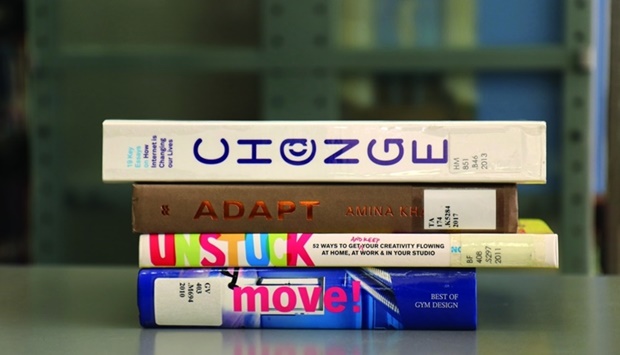As artists and designers across Doha, and elsewhere, turned to their tools – paints, brushes, laptops, clay, wood, film, textiles, stone and so on – as an outlet for their emotions or to bring the experiences they went through during the pandemic lockdown, to life, a staff member at Virginia Commonwealth University School of the Arts in Qatar (VCUarts Qatar), a Qatar Foundation partner university, created an exhibit using a medium she was most familiar with – books.

In a display titled ‘1.5 meter’, Roshni Baker, Public Services and Outreach co-ordinator, VCUarts Qatar Libraries, used spine poetry – where books are stacked so that their titles read from top to bottom as a poem – to capture the roller coaster of emotions that she in particular, and the public in general, went through during these recent challenging times.
“Artists and designers are basically storytellers using different media to tell their stories,” Baker says. “Libraries have a long tradition of storytelling and this display can be viewed as another version of storytelling. The idea behind the ‘1.5 meter’ display was to capture the moments and stories of the pandemic. I felt the need for documenting or narrating these extraordinary moments in history in some way.
“The pandemic has affected everyone. But the manner and timeline in which it affected each one of us was, and continues to be, different. Hence, our stories are different. The spine poetry display I created is interactive in the sense that it invites viewers to see if they can relate to the stories displayed.”
Baker says that spine poetry – often referred to as ‘found’ poetry – is one of the creative pursuits that anyone with a collection of books, and a passion for storytelling, can undertake at home.
“In addition to spine poetry, there are other ways to creatively use words,” she adds. “For instance, blackout poetry is another form of found poetry where you select a few words from a text in a book or a newspaper, and black out the rest of the words creating a new story from the existing text.”
The university’s Art and Design Library boasts of a physical collection of almost 40,000 titles that directly support the school’s curriculum. It further provides students and faculty with 24/7 access to digital collections, including a million ebooks and over 80 subject databases that link to millions of online articles.
Additionally, the library is building up a comprehensive collection related to areas of Islamic art, and contemporary Arab art and design.
VCUarts Qatar’s Art and Design Library is open to the public during business hours, Sunday–Thursday from 9am to 6pm (closed Friday/Saturday). Community members who want to borrow books can apply for a membership card. Details and requirements for library membership can be found on the library's website at https://qatar.vcu.edu/library
VCUarts Qatar Libraries also have special collections that include artists’ books and rare books on the history and culture of Qatar. The space and culture of the Art and Design Library is also unique and special within Education City, not only because of its specialised collections, but also because it re?ects the learning and working practices of artists and designers.

In a display titled ‘1.5 meter’, Roshni Baker, Public Services and Outreach co-ordinator, VCUarts Qatar Libraries, used spine poetry – where books are stacked so that their titles read from top to bottom as a poem – to capture the roller coaster of emotions that she in particular, and the public in general, went through during these recent challenging times.
“Artists and designers are basically storytellers using different media to tell their stories,” Baker says. “Libraries have a long tradition of storytelling and this display can be viewed as another version of storytelling. The idea behind the ‘1.5 meter’ display was to capture the moments and stories of the pandemic. I felt the need for documenting or narrating these extraordinary moments in history in some way.
“The pandemic has affected everyone. But the manner and timeline in which it affected each one of us was, and continues to be, different. Hence, our stories are different. The spine poetry display I created is interactive in the sense that it invites viewers to see if they can relate to the stories displayed.”
Baker says that spine poetry – often referred to as ‘found’ poetry – is one of the creative pursuits that anyone with a collection of books, and a passion for storytelling, can undertake at home.
“In addition to spine poetry, there are other ways to creatively use words,” she adds. “For instance, blackout poetry is another form of found poetry where you select a few words from a text in a book or a newspaper, and black out the rest of the words creating a new story from the existing text.”
The university’s Art and Design Library boasts of a physical collection of almost 40,000 titles that directly support the school’s curriculum. It further provides students and faculty with 24/7 access to digital collections, including a million ebooks and over 80 subject databases that link to millions of online articles.
Additionally, the library is building up a comprehensive collection related to areas of Islamic art, and contemporary Arab art and design.
VCUarts Qatar’s Art and Design Library is open to the public during business hours, Sunday–Thursday from 9am to 6pm (closed Friday/Saturday). Community members who want to borrow books can apply for a membership card. Details and requirements for library membership can be found on the library's website at https://qatar.vcu.edu/library
VCUarts Qatar Libraries also have special collections that include artists’ books and rare books on the history and culture of Qatar. The space and culture of the Art and Design Library is also unique and special within Education City, not only because of its specialised collections, but also because it re?ects the learning and working practices of artists and designers.

